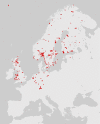Use of necrophagous insects as evidence of cadaver relocation: myth or reality?
- PMID: 28785513
- PMCID: PMC5543926
- DOI: 10.7717/peerj.3506
Use of necrophagous insects as evidence of cadaver relocation: myth or reality?
Abstract
The use of insects as indicators of post-mortem displacement is discussed in many texts, courses and TV shows, and several studies addressing this issue have been published. Although the concept is widely cited, it is poorly understood, and only a few forensic cases have successfully applied such a method. The use of necrophagous insects as evidence of cadaver relocation actually involves a wide range of biological aspects. Distribution, microhabitat, phenology, behavioral ecology, and molecular analysis are among the research areas associated with this topic. This article provides the first review of the current knowledge and addresses the potential and limitations of different methods to evaluate their applicability. This work reveals numerous weaknesses and erroneous beliefs as well as many possibilities and research opportunities.
Keywords: Biotope; Blow flies; Crime scene investigation; Forensic entomology; Forensic pathology; Larvae; Necrophagous; Taphonomy.
Conflict of interest statement
The authors declare that they have no competing interests.
Figures

Similar articles
-
[Thermoregulation behavior in necrophagous dipteran larvae].Med Sci (Paris). 2017 Aug-Sep;33(8-9):779-783. doi: 10.1051/medsci/20173308024. Epub 2017 Sep 18. Med Sci (Paris). 2017. PMID: 28945569 Review. French.
-
[Investigation of the Necrophagous Flies in Beijing].Fa Yi Xue Za Zhi. 2017 Jun;33(3):267-270. doi: 10.3969/j.issn.1004-5619.2017.03.011. Epub 2017 Jun 25. Fa Yi Xue Za Zhi. 2017. PMID: 29230992 Chinese.
-
[Forensic entomology].Turkiye Parazitol Derg. 2010;34(3):216-21. Turkiye Parazitol Derg. 2010. PMID: 20954127 Review. Turkish.
-
Analysis of the 13C isotope ratios of amino acids in the larvae, pupae and adult stages of Calliphora vicina blow flies and their carrion food sources.Anal Bioanal Chem. 2018 Dec;410(30):7943-7954. doi: 10.1007/s00216-018-1416-9. Epub 2018 Oct 25. Anal Bioanal Chem. 2018. PMID: 30357442
-
Molecular identification of blow flies recovered from human cadavers during crime scene investigations in Malaysia.Malays J Pathol. 2012 Dec;34(2):127-32. Malays J Pathol. 2012. PMID: 23424775
Cited by
-
Looking Back to Move Forward: How Review Articles Could Boost Forensic Entomology.Insects. 2021 Jul 15;12(7):648. doi: 10.3390/insects12070648. Insects. 2021. PMID: 34357308 Free PMC article.
-
Larval identification key to necrophagous Coleoptera of medico-legal importance in the western Palaearctic.Int J Legal Med. 2018 Nov;132(6):1795-1804. doi: 10.1007/s00414-018-1909-2. Epub 2018 Aug 3. Int J Legal Med. 2018. PMID: 30076465
-
Temperature models of development for Necrodes littoralis L. (Coleoptera: Silphidae), a carrion beetle of forensic importance in the Palearctic region.Sci Rep. 2022 Jun 11;12(1):9689. doi: 10.1038/s41598-022-13901-y. Sci Rep. 2022. PMID: 35690667 Free PMC article.
-
Forensic entomology in homicide cases: study of a corpse found inside a buried vehicle.Forensic Sci Med Pathol. 2025 Mar;21(1):358-365. doi: 10.1007/s12024-024-00889-2. Epub 2024 Sep 4. Forensic Sci Med Pathol. 2025. PMID: 39230841
-
Predicting Geographic Distribution of Forensically Significant Blow Flies of Subfamily Chrysomyinae (Diptera: Calliphoridae) in Northern Thailand.Insects. 2018 Aug 21;9(3):106. doi: 10.3390/insects9030106. Insects. 2018. PMID: 30134628 Free PMC article.
References
-
- Abd El-Bar MM, Sawaby RF. A preliminary investigation of insect colonization and succession on remains of rabbits treated with an organophosphate insecticide in El-Qalyubiya Governorate of Egypt. Forensic Science International. 2011;208(1–3):e26–e30. doi: 10.1016/j.forsciint.2010.10.007. - DOI - PubMed
-
- Abdel-Shafy S, El-Khateeb RM, Soliman MM, Abdel-Aziz MM. The efficacy of some wild medicinal plant extracts on the survival and development of third instar larvae of Chrysomyia albiceps (Wied) (Diptera: Calliphoridae) Tropical Animal Health and Production. 2009;41(8):1741–1753. doi: 10.1007/s11250-009-9373-0. - DOI - PubMed
-
- Ali Hanafi-Bojd A, Yaghoobi-Ershadi MR, Haghdoost AA, Akhavan AA, Rassi Y, Karimi A, Charrahy Z. Modeling the distribution of cutaneous leishmaniasis vectors (Psychodidae: Phlebotominae) in Iran: a potential transmission in disease prone areas. Journal of Medical Entomology. 2015;52(4):557–565. doi: 10.1093/jme/tjv058. - DOI - PubMed
LinkOut - more resources
Full Text Sources
Other Literature Sources

